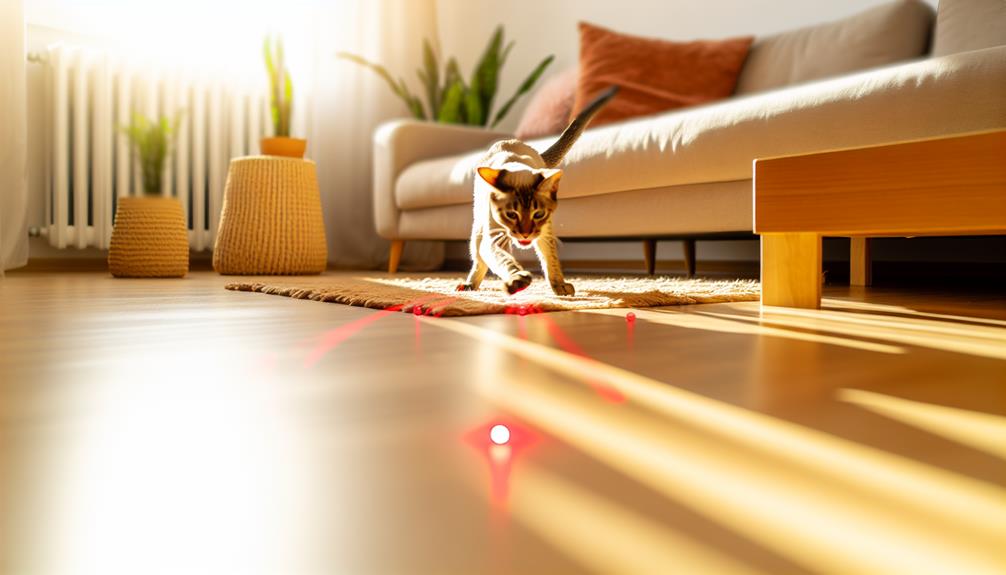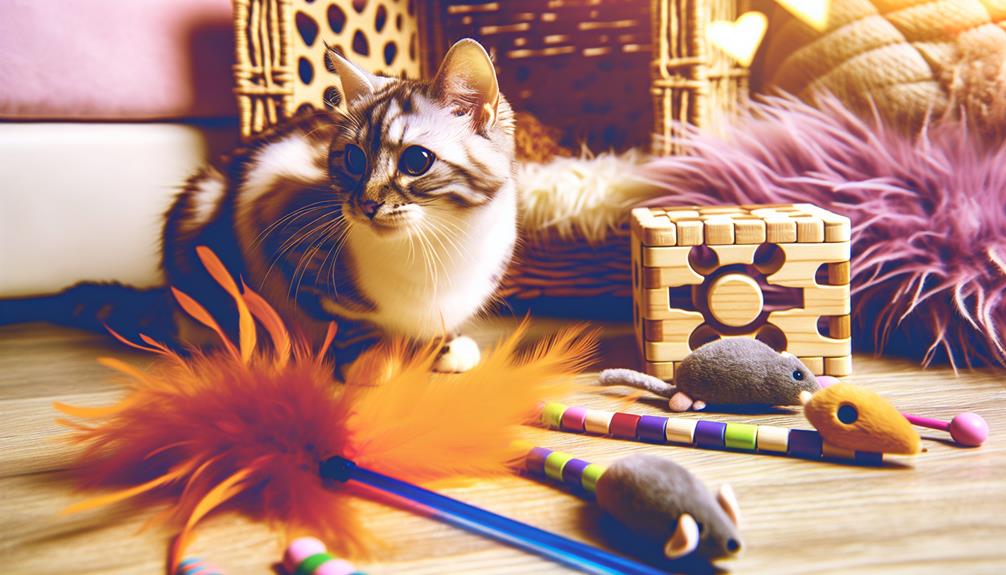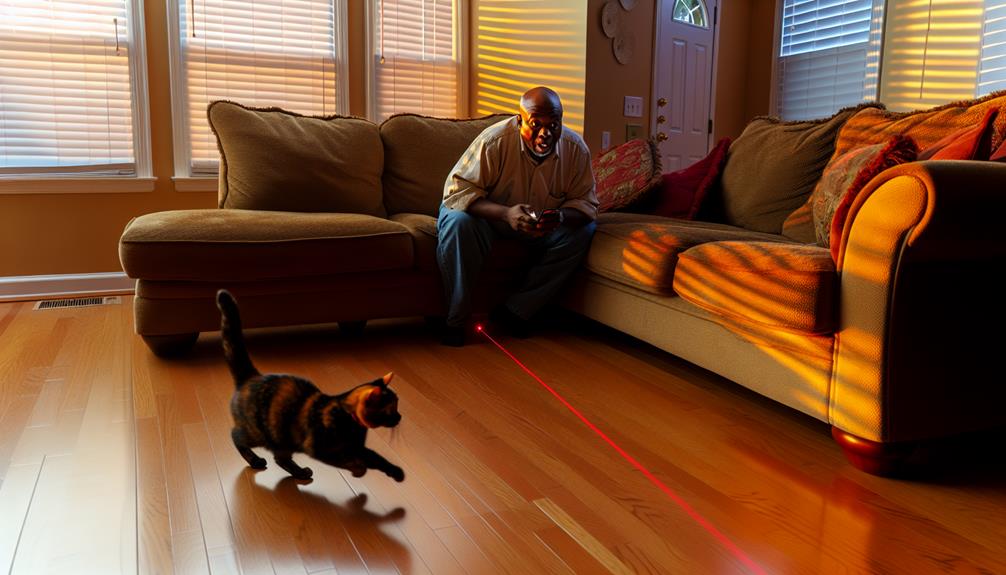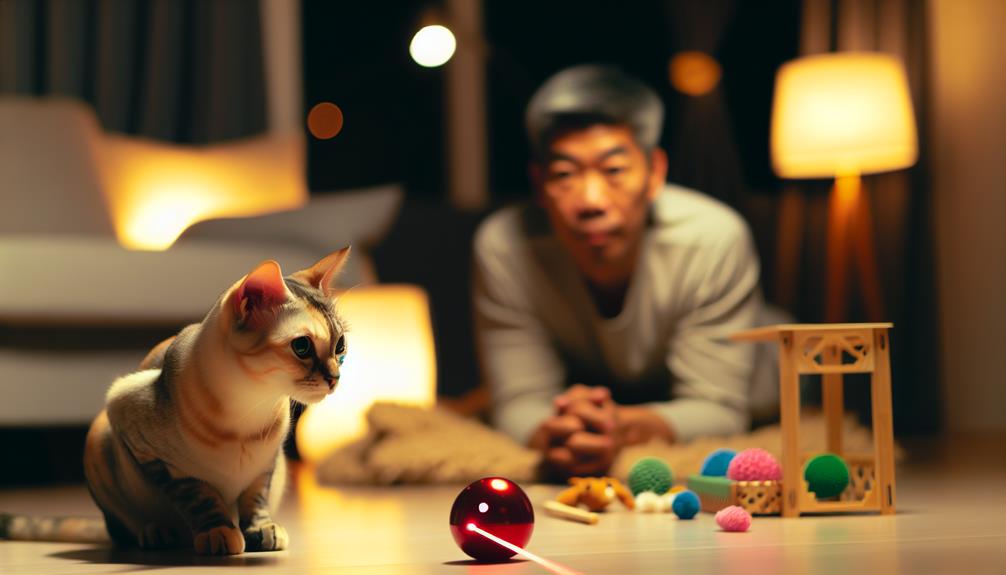When you use a laser pointer to play with your cat, it can seem like a great way to keep them active and entertained. But have you ever considered the potential drawbacks? While it's fun to watch your feline friend chase that elusive red dot, the inability to actually catch it can lead to frustration and stress. There's also the risk of eye damage if the laser isn't handled carefully. So, you might be asking yourself, are laser pointers truly bad for cats? Let's explore the nuances of this seemingly simple toy and uncover the full picture.
Physical Health Risks
When considering the use of laser pointers for cat play, it's vital to acknowledge the potential physical health risks involved. One of the most significant concerns is eye damage. Laser pointers emit concentrated light that, when directed at a cat's eyes, can cause retinal injury. The retina is highly sensitive, and even brief exposure to the laser beam can lead to temporary or permanent vision impairment. You should always avoid pointing the laser directly at your cat's face, as this increases the risk of ocular trauma.
Additionally, there's the risk of a heightened stress response. While cats are natural hunters, the elusive nature of the laser beam can lead to frustration. This frustration manifests physically through increased heart rate and stress hormone production, which can have long-term health implications. Chronic stress in cats has been linked to a variety of health issues, including gastrointestinal problems and a weakened immune system.
Moreover, the vigorous physical activity induced by chasing a laser pointer can lead to overexertion. Cats with preexisting conditions such as arthritis or heart disease may be at higher risk of injury or exacerbation of their condition. As a result, it's important to monitor your cat's physical condition during and after play sessions.
Psychological Impact
Beyond the physical health risks, the psychological impact of using laser pointers for cat play is equally important to contemplate. When you engage your cat with a laser pointer, you're providing cognitive stimulation, but it's a double-edged sword. The elusive nature of the laser can elevate frustration levels because your cat can't actually "catch" the prey. This lack of tangible success can lead to increased stress and anxiety.
Cats are predatory animals, and their hunt involves a sequence of behaviors: stalking, chasing, pouncing, and capturing. The laser pointer interrupts this natural sequence, leaving out the essential capture phase. When they can't complete the hunt, it may result in behavioral issues such as aggression, over-grooming, or withdrawing from play altogether.
Here's a table that outlines the key psychological impacts:
| Psychological Aspect | Positive Impact | Negative Impact |
|---|---|---|
| Cognitive Stimulation | Keeps mind active | May become obsessive |
| Frustration Levels | Temporary excitement | Long-term stress and anxiety |
| Behavioral Changes | Initial play engagement | Aggression, over-grooming |
| Emotional Well-being | Momentary joy | Potential for chronic frustration |
| Hunting Satisfaction | None | Disrupted natural hunting cycle |
While laser pointers can be a fun and engaging way to play with your cat, it's essential to balance this activity with other forms of play that allow your cat to capture and "kill" the prey. Alternatives like interactive toys or feather wands can provide both cognitive stimulation and the satisfaction of a successful hunt, mitigating some of the negative psychological impacts associated with laser pointer play.
Benefits of Laser Play

Laser play offers several benefits for your feline companion, primarily revolving around physical exercise and mental engagement. When your cat chases that elusive red dot, it's not just a game; it's a full-body workout. This type of high-intensity activity helps to maintain muscle tone, supports cardiovascular health, and can even aid in weight management. Cats, particularly indoor ones, often suffer from obesity and related health issues. Regular laser play can mitigate these risks by providing essential exercise benefits.
Moreover, the mental engagement involved in laser play shouldn't be underestimated. Cats are natural hunters, and the unpredictable movement of the laser mimics the erratic behavior of prey. This stimulates your cat's predatory instincts and keeps their mind sharp. Cognitive stimulation is vital for preventing boredom and the behavioral problems that can arise from it, such as excessive grooming or destructive scratching.
Another significant advantage of laser play is the bonding time it facilitates between you and your pet. Interactive play is a cornerstone of a healthy human-animal bond. Engaging in activities like laser play allows you to spend quality time with your cat, reinforcing your relationship and building trust. For shy or anxious cats, this can be an especially effective way to encourage positive interactions.
Safe Usage Tips
To guarantee your cat's safety during laser play, it's essential to limit sessions to a few minutes to prevent overstimulation and frustration. Additionally, incorporating physical toys can provide tangible rewards, promoting a more balanced and satisfying play experience. Evidence suggests that alternating between laser pointers and physical toys can enhance your cat's mental and physical well-being.
Controlled Play Sessions
When engaging in controlled play sessions with your cat, it's vital to guarantee the activity is both safe and enriching. Interactive play is important for feline exercise, mental stimulation, and overall well-being. When using a laser pointer, it's important to avoid shining the light directly into your cat's eyes to prevent retinal damage. Instead, focus on creating dynamic movements that mimic the erratic behavior of prey, encouraging your cat to stalk and pounce.
Ensure the play sessions are timed and limited to avoid overstimulation. A good rule of thumb is to engage your cat for about 10-15 minutes per session. This duration is sufficient to provide adequate physical activity and mental engagement without causing undue stress. Additionally, always conclude the session by letting your cat catch a tangible object, such as a toy, to satisfy their predatory instincts. This helps prevent frustration and promotes a sense of accomplishment.
Incorporate Physical Toys
Often overlooked, physical toys are essential for diversifying your cat's playtime and ensuring holistic development. While laser pointers can stimulate a cat's hunting instincts, they lack the tangible reward that physical toys provide, which is vital for your cat's mental and physical well-being.
To enhance your cat's interactive play experience, consider integrating a variety of physical toys:
- Feather Wands: Mimic the movement of birds, engaging your cat's hunting instincts and promoting physical exercise.
- Puzzle Feeders: Stimulate cognitive function and provide a rewarding experience that combines play with nutrition.
- Stuffed Mice: Help satisfy your cat's need to capture and bite, offering a more realistic hunting scenario.
- Interactive Ball Toys: Encourage chasing and batting, which are essential for maintaining agility and overall fitness.
Alternative Toys

Many cat owners are always on the lookout for alternative toys that can engage their feline friends without the risks associated with laser pointers. Fortunately, there are numerous options that not only entertain but also provide mental and physical benefits. Interactive puzzles, for instance, stimulate your cat's cognitive functions and problem-solving skills. These toys often involve hidden treats, making them an excellent choice for keeping your cat engaged.
Feather wands mimic the erratic movement of birds, fulfilling your cat's predatory instincts. They're fantastic for interactive play sessions and help build the bond between you and your pet. Catnip toys, infused with the natural herb, can have a euphoric effect on cats, encouraging them to play and exercise.
Treat dispensers combine the allure of food with the challenge of earning it, promoting both mental and physical activity. Ball tracks are another interactive option, providing endless entertainment as your cat swats the ball around the track. Scratching posts are essential for maintaining healthy claws and providing an acceptable outlet for scratching behavior.
Tunnel toys offer a secluded space for your cat to explore, hide, and play. Fish toys, especially those that move or flop, can captivate your cat's attention and stimulate their hunting instincts.
Here's a quick comparison of some popular alternative toys:
| Toy Type | Benefits | Potential Drawbacks |
|---|---|---|
| Interactive Puzzles | Cognitive stimulation, treats | Requires supervision, setup time |
| Feather Wands | Predatory play, bonding | May wear out quickly |
| Catnip Toys | Increased activity, euphoria | Some cats may not respond |
| Treat Dispensers | Mental/physical exercise | Overfeeding risk |
| Ball Tracks | Continuous entertainment | Might lose interest over time |
| Scratching Posts | Claw health, acceptable scratching | Need regular replacement |
| Tunnel Toys | Exploration, hiding | Can take up space |
| Fish Toys | Stimulates hunting instincts | Limited battery life, noise |
Expert Opinions
Experts caution that while laser pointers can stimulate your cat mentally, they may also contribute to behavioral health concerns such as frustration and anxiety due to the inability to catch the elusive light. Veterinarians further emphasize the physical safety risks, including potential eye damage if the laser is pointed directly at your cat's eyes. Peer-reviewed studies suggest considering these factors when deciding on appropriate play methods for your feline companion.
Behavioral Health Concerns
While the allure of watching cats chase the elusive red dot of a laser pointer is undeniable, there are significant behavioral health concerns associated with this activity. When cats engage with laser pointers, their natural feline instincts and hunting behavior can be disrupted, leading to several potential issues.
- Frustration: Chasing a laser pointer without the opportunity to capture and "kill" the prey may result in heightened frustration. This can manifest in aggressive behavior or anxiety.
- Obsessive Behavior: Some cats may develop an unhealthy fixation on light sources, leading to obsessive behaviors. This can include compulsive chasing of reflections or light spots, even when the laser pointer isn't in use.
- Lack of Satisfaction: A cat's hunting behavior is a sequence of stalking, chasing, and capturing. Laser pointers only fulfill the chase aspect, leaving cats without a sense of accomplishment, which is essential for their mental well-being.
- Redirected Aggression: Some cats might redirect their pent-up frustration onto other pets or humans, leading to unexpected and potentially dangerous interactions.
Physical Safety Risks
In addition to behavioral health issues, there are notable physical safety risks associated with using laser pointers for cats. One significant concern is vision damage. Direct exposure to a laser pointer's beam can cause eye injury, which may lead to retinal damage or even permanent vision loss. It's vital to avoid shining the laser directly into your cat's eyes to mitigate this risk.
Moreover, laser pointers can elevate your cat's stress levels. The inability to catch the elusive light can frustrate their natural hunting instincts, leading to increased play aggression and diminished frustration tolerance. These heightened stress levels aren't just a behavioral concern; they can manifest physically, increasing the likelihood of injuries from aggressive play or accidents.
While laser pointers can help meet your cat's exercise needs, it's important to implement safety precautions. Make sure that play sessions are balanced with tangible toys they can catch and "defeat." This approach reduces the risk of overexertion and associated injuries.
Ultimately, understanding the physical safety risks allows you to make informed decisions. Incorporate safer play alternatives and always prioritize your cat's overall well-being to avoid unnecessary harm.
Reader Experiences

Many readers have shared diverse experiences with using laser pointers to engage their feline companions. These insights offer a nuanced understanding of both the benefits and potential drawbacks of this popular cat toy. By examining these first-hand accounts, we can better understand how laser pointers impact cat engagement and owner observations.
- Enhanced Physical Activity: Many owners note that laser pointers greatly increase their cat's physical activity. Cats seem more animated and agile, chasing the elusive red dot with enthusiasm. This can be especially beneficial for indoor cats that might otherwise lack sufficient exercise.
- Behavioral Changes: Conversely, some readers have observed negative behavioral changes. After play sessions with laser pointers, a few cats exhibit signs of frustration or agitation, likely due to the inability to "catch" the light. This can lead to obsessive behaviors or increased anxiety.
- Interactive Playtime: A positive aspect highlighted by several owners is the enhancement of interactive playtime. Laser pointers allow for a dynamic way to bond with your cat, providing mental stimulation and enriching the human-animal relationship. However, it is vital to couple laser play with tangible rewards, like treats or physical toys, to satisfy their hunting instincts.
- Ophthalmic Concerns: Medical professionals and some readers have raised concerns about the potential for retinal damage. Direct exposure to the laser beam, even for short periods, can harm a cat's eyes. Ensuring the laser is never pointed directly at the eyes is imperative.
Conclusion
In the grand tapestry of feline enrichment, laser pointers can be both a bright spot and a potential pitfall. Use them sparingly, like seasoning in a gourmet dish, to avoid the bitterness of frustration and the sting of eye strain. Always balance the elusive light with tangible toys, ensuring your cat's playtime ends with the satisfying catch of something real. By weaving in these practices, you'll create a harmonious blend of excitement and well-being for your furry friend.
